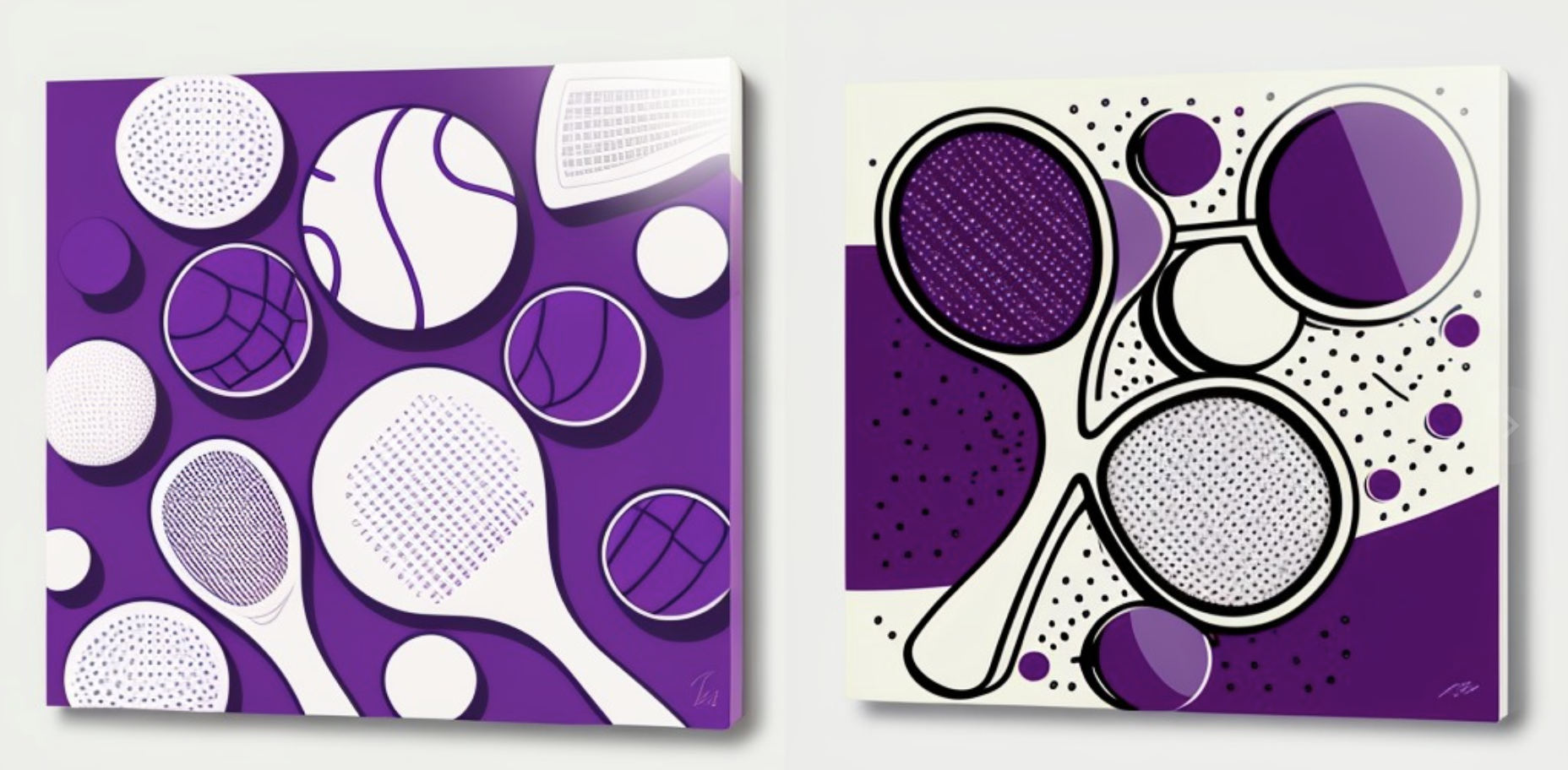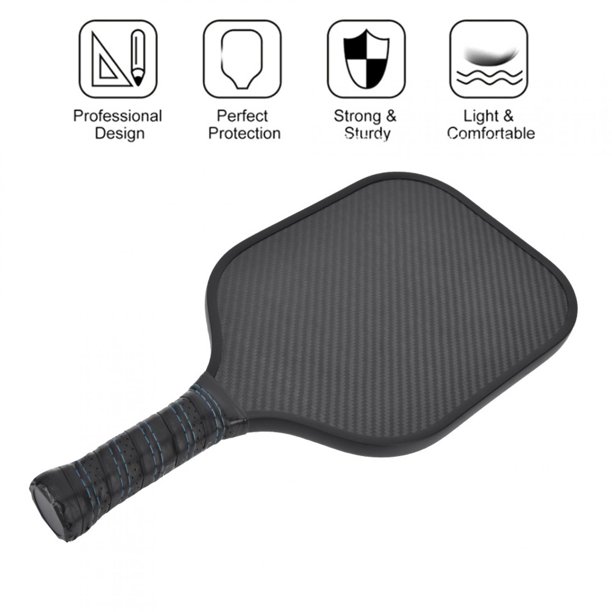
[monsterinsights_popular_posts_inline]
While playing pickleball, one of the fundamental things you should be aware of is that no two paddles are made equal. Are you confused about the best pickleball paddle material? Then, you aren’t alone. Most individuals have difficulties recognizing the distinction between different materials of pickleball paddles.

As paddle material is one of the most important factors to consider when selecting a paddle, you must select a material that complements your playing style and preferences.
Graphite and composite are the two popular materials used to make pickleball paddles. Each offers unique characteristics and benefits, making them an excellent option for different playing styles and preferences. It can be challenging for a beginner to decide which is right for you. This guide will help you understand graphite pickleball paddles vs composite pickleball paddles.
What Is The Best Material For Pickleball Paddle?
Graphite paddles and composite paddles are the most common and finest paddle materials. It relies on your playing style and personal preferences to determine which of these two materials is superior. However, you must always choose between fiberglass and graphite pickleball and prevent wood paddles.
Usually, composite paddles are composed of carbon fiber, fiberglass, and Kevlar, rendering them extremely robust. With a higher percentage of graphite fibers, graphite paddles are lighter weight and easier to swing.
Yet, this is just a basic distinction. We will discuss in detail about the graphite paddles vs composite paddles. After comparing graphite, composite, and wooden paddles, you can select a great paddle that best matches your skill level.
Reasons To Choose The Best Pickleball Paddles Material

Your performance mostly relies on the paddle you select. Therefore, playing pickleball with the right paddle that best suits you is essential. However, if you visit any store, you will notice that distinct materials are available. Each has distinct perks and is designed for specific player types.
Understanding the advantages and disadvantages of each material will assist you in improving your game if you choose the proper material.
Some other reasons why to consider the right material of a pickleball paddle is:
- Durability: The best material should be durable and long-lasting. Also, it should withstand regular use without easily chipping, cracking, or breaking.
- Comfort: The material used in a pickleball paddle should provide a comfortable grip and not cause discomfort or hand fatigue.
- Control: A good material should allow for better control and precision in your shots.
- Lightweight: Paddle weight also matters. A lighter paddle will allow quicker, more accurate shots and improved maneuverability.
- Noise: Certain materials can produce a loud, distracting sound when hitting the ball. The best material should produce minimal noise and not disturb other players.
- Price: Price is an important factor when choosing a pickleball paddle. The best material of a good paddle should be affordable yet still offer high-quality performance.
- Bounce: The material used in a pickleball paddle should have good bounce characteristics to allow for consistent, accurate shots.
- Weather Resistance: The material used in a pickleball paddle should be weather resistant and not easily affected by extreme temperatures or humidity.
Understanding The Construction Of Pickleball Paddle
Typically, a pickleball paddle consists of three layers. The one in the middle is known as the core, whereas the ones on the sides are referred to as faces or hitting surfaces.
The hitting surface is often composed of graphite or composite, but the core is typically composed of Nomex, aluminum, or plastic.
There is no distinction between the core and face materials for wooden paddles.
Initially, pickleball paddles were constructed of wood, but as newer materials have become available, wooden paddles are no longer the favored alternative. They lack the control and spin of graphite or composite material paddles. However, wooden paddles are significantly more durable and inexpensive. Consider these if purchasing paddles for children, community centers, or schools.
In addition, many beginner paddlers utilize a wooden paddle to play pickleball and acquaint themselves with the sport. Also, it helps them to determine their preferences before investing in a graphite or fiberglass paddle. The core and face of such paddles are both made of wood.
Graphite and Composite Pickleball Paddles: Understanding The Differences

So here are the major differences between a composite and graphite paddle.
Cost
Let’s be frank: one of the primary things that come to mind while considering a purchase is the cost. The price difference between graphite and composite paddles is negligible.
Composite pickleball paddles are often less expensive as compared to graphite paddles and fiberglass paddles. Wooden paddles are often the least expensive. However, you should only use them in social settings and not during tournaments.
Composite pickleball paddle includes wood, plastic, and fiberglass. Graphite paddles are composed of graphite, a lightweight and durable material. In addition, composite paddles are more robust and feature a larger sweet spot.
Material & Structure
A composite pickleball paddle is one manufactured from a combination of materials. Usually, Nomex or polymer cores are employed to construct composite paddles. When combined, these components provide a foam like body with a softer and quiet texture.
Typically, the actual surface that gets into touch with the ball consists of an open-celled honeycomb paddle core topped with one or several paddle face materials.
In contrast to composite, graphite pickleball paddles have graphite coating in the paddle’s core. Graphite is a tough substance, so the graphic pickleball is somewhat a heavier paddle. Yet it is not such a heavy paddle that you can’t play!
A graphite pickleball paddle encourages a great deal of wrist action. Moreover, several players prefer wrist action because it enhances their reaction to attacking shots.
Edge Guard vs. Edgeless

When choosing pickleball paddles, you will see edge guard and edgeless options. Whether you pick a composite or graphite paddle has no impact on whether you select a paddle with edge protection or one without.
A band of material surrounds a pickleball paddle’s striking region, often rubber, known as an edge guard.
Edge guards have two purposes: first, to preserve the paddle’s playing surface from damage, and second, to enhance the size of the paddle’s “sweet spot” by allowing a bigger margin of error while striking the ball.
Edge guards are an essential component of most pickleball paddles and may dramatically increase the paddle’s durability.
When purchasing a new paddle, look for one with a robust edge guard that can withstand heavy handling.
Weight
Despite containing graphite, graphite paddles are often lighter than composite paddles. The usual weight of graphite paddles is approximately 7.5 ounces, but composite paddles weigh roughly 8 ounces. A lighter paddle is ideal for beginning players with a background of tennis elbow, shoulder injury, or other arm difficulties. Moreover, lighter weight paddles generally are more control-oriented than power-oriented. Also, lighter paddles with a graphite surface facilitates drop shots and dinks.
Paddle Texture
Regarding texture, a textured surface is necessary for putting a spin on the ball. Because composite paddles possess a more textured surface, they will impart greater spin to the ball. So this is useful for more advanced players. Generating more spin is advantageous when using a heavier paddle because it allows for greater ball control. Moreover, Fiberglass composite paddles now tend to be popular because of their spin.
Durability
When comparing graphite vs composite pickleball paddles, durability is an also essential factor.
Graphite paddles are highly durable. They will have greater durability than composite paddles. Many individuals choose graphite for its durability. Regardless of the kind, all paddles will eventually require replacing.
Whether you go for a pickleball paddle face made of graphite, composites, plastic, or wood, select a face containing UV inhibitors to prevent sun damage and discoloration.
This provides the best possibility of keeping the pickleball paddle face of your choice. Moreover, the most essential aspect of any purchase is ensuring you receive good value for your money.
Graphite vs Composite Pickleball Paddles – Pros And Cons For Composite Paddle
The pros of composite pickleball paddle are as follows:
- First, the composite paddle is more robust and pushes forward.
- Second, composite paddles seem to be more durable because they are less prone to shatter or crack.
- Composites provide improved ball control and are less inclined to “chatter” when striking the ball.
Some of the cons of these paddles are:
- They are often heavier than conventional paddles, making them more difficult to handle.
- In addition, composite paddles produce a distinctive sound when striking the ball, which might distract opposing players.
- Lastly, composite paddles are typically more expensive than other varieties, which may discourage some players from using them.
Graphite vs Composite Pickleball Paddles – Pros And Cons For Graphite Paddles

There are several advantages to having graphite paddles.
- First, graphite pickleball paddles are powerful. A graphite pickleball paddle can create great speed and force while striking the ball, making them ideal for competitive play.
- They are also lightweight. This makes them easier to swing and control, and it also ensures your arm won’t fatigue as quickly as it would with a heavier paddle.
- Finally, they are quiet. This can be a huge advantage if you’re participating in a tournament or competitive environment where silence is essential.
Some of the cons of graphite pickleball paddles are as follows:
- One disadvantage is that they might give less control than other paddles. This can make accurate shot placement more difficult and increase the likelihood of making mistakes.
- Another possible disadvantage is the expense. Graphite paddles may be excessively pricey for certain players.
- Lastly, graphite pickleball paddles may be less durable than other materials. Moreover, they may be more susceptible to damage from strong strikes and less durable than other varieties of paddles.
Conclusion
Deciding the material of your pickleball paddle might be difficult, mainly if it’s your first time purchasing one. However, this comparison of graphite and composite pickleball paddles can help you figure out the ideal paddle.